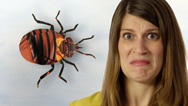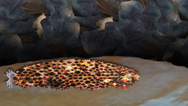The Castrating Zombie Parasite
- By Anna Rothschild
- Posted 04.30.15
- NOVA
The parasite Loxothylacus panopaei makes male crabs think that they’re pregnant females. Learn more in this episode of Gross Science.
Transcript
The Castrating Zombie Parasite
Posted: April 30, 2015
Most of us know barnacles as those small, shelled creatures you find at the beach attached to rocks and piers. But, there’s one species of barnacle with a very different sort of life cycle. It’s a parasite that castrates crabs and turns them into barnacle baby-making machines.
I’m Anna Rothschild, and this is Gross Science.
So this parasitic barnacle is called Loxothylacus panopaei, and it starts out its life just like most barnacles do—as a free-swimming creature looking for a home. And, home for this particular parasite is inside of a mud crab.
When a young female barnacle finds a mud crab (and let’s say it’s a male mud crab, though they infect females as well) she undergoes a transformation, losing her eyes and legs. Then, she injects herself into the crab’s circulatory system. Once inside she starts forming a root system throughout the crab’s body, castrating him in the process. Soon, a sac starts poking out from the crab’s abdomen. This is an “externa,” the reproductive organs of the adult female barnacle.
The externa attracts male barnacles, and when a male arrives he injects his own cells into the sac, which grow into a testicle-like structure. In fact, the adult male barnacle exists only as a testicle, fertilizing the female barnacle’s eggs.
You might be wondering what’s happened to the crab after all this. Well, believe it or not, he’s definitely still alive, but he’s no longer quite himself. To begin with, his abdomen has widened, so he looks a little bit more like a female crab. And, by the time the parasite’s eggs are fertilized, this male crab is convinced that he’s pregnant! He cares for the eggs in the externa like they’re his own babies, until the parasitic spawn are released and the cycle begins again.
So, this is all pretty creepy, but why should we care? Well, these parasites can be extremely prolific—for example, in some places in the Chesapeake Bay up to 75% of the mud crabs are infected, which means that none of those crabs can reproduce. And, Loxothylacus panopaei isn’t the only species of castrating, parasitic barnacle out there. There are other species that infect other crustaceans, like blue crabs and shrimp, which make up parts of our food supply. So, while these barnacles can’t actually infect humans, they’re not just a problem for crabs—they could be a problem for us, too.
Ew.
Credits
PRODUCTION CREDITS:
- Host, Writer, Animator, Editor
- Anna Rothschild
- DP, Sound, Researcher, Intern Extraordinaire
- Kristen Clark
- Many thanks to Monaca Noble and Amy Fowler.
- Mambo Bar
- Music Provided by APM
IMAGES
- Crab with Externa
- ©SERC (The Smithsonian Environmental Research Center)
- Blistering barnacles on a jetty
- Flickr/Mo Riza
- Canto White Boiled Shrimp
- Wikimedia Commons/Alpha
- Blue crab on market in Piraeus
- Wikimedia Commons/wpopp
SFX
(used with permission from author)
IMAGE
- (main image: Illustrated Crab)
- ©WGBH Educational Foundation
Sources
Want more info?
The Smithsonian Environmental Research Center’s on-going study on Loxothylacus panopaei: http://bit.ly/1JyRsbQ
Related Links
-

Gross Science
Bizarre stories from the slimy, smelly, creepy world of science.
-

Kangaroo Gas and Global Warming
Can kangaroo farts teach us how to make cattle and other livestock more eco-friendly?
-

The Poop Cure
Fecal transplants are surprisingly effective cures for a dangerous bacterial infection.
-

Sea Cucumber Evisceration
Sea cucumbers can expel their internal organs and then regrow them.

